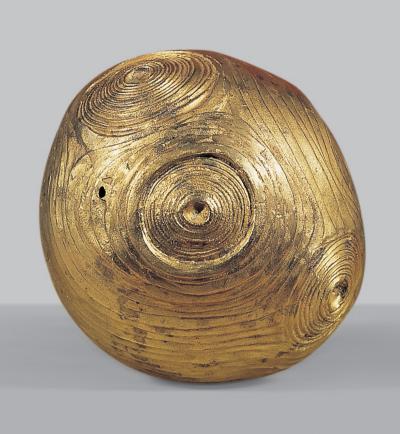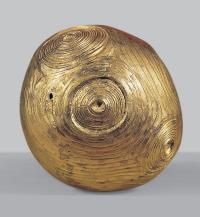Inner Space
 Work Artirst Modal
Work Artirst Modal
Inner Space
Takis (Panayiotis Vassilakis) (1925 Athens)
In 1954, he settled in Paris. During that same year, he initiated his “Signals” series – kinetic sculptures producing musical sounds as they chime in the wind. In 1959, he showed at Iris Clert Gallery his first “Telemagnetic Sculptures”, making use of electromagnetic fields and, thus, making the invisible energy encompassing the universe perceptible. Light and motion, in all its manifestations – mechanical, electromechanical, thermal, magnetic, hydrodynamic – have also been at the core of his work. Coming soon thereafter, his “Télélumières” were based on electromagnetic qualities. In fact, during a performance at the Iris Clert Gallery in 1960, thanks to a magnetic device invented by the artist, the poet Sinclair Beiles was suspended several feet above ground while reciting the “Magnetic Manifesto”. That same year also marked the beginning of the long-standing partnership between Takis and Alexander Iolas, with the artist’s first solo exhibition in New York held at the latter’s gallery. During his stay in Paris, Takis met and befriended American writers of the Beat Generation and, while in New York, he met Marcel Duchamp. In 1961, he published his autobiography under the title Estafilades.
Invited by MIT during 1968-1969, he created his first “Hydromagnetic Sculptures”, while he had already initiated his “Musical Sculptures” series, in which musical sound was produced through random magnet movement, back in 1965. His research along these lines continued with the production of musical rooms as well as musical and choreographic happenings, culminating in 1992 with the transformation of the aqueduct in the city of Beauvais into a huge musical sculpture. In 1974, he began producing casts of male and female bodies – the first in a series of erotic sculptures.
In the course of his long artistic career, Takis organized major solo exhibitions, the most prominent of which were his retrospectives at the Centre National d'Art Contemporain (1972) and the Galerie Nationale du Jeu de Paume (1993), the latter being brought to the Athens School of Fine Arts “Factory” venue in 1994. In 1999, he presented his “Photovoltaic Sculptures” for the first time, in the context of the exhibition “Takis Millennium”. His exhibition activity also includes participations in major group events, including the Documenta in Kassel (1977) and “The Century of Kafka” at the Centre Georges Pompidou (1984), as well as his representation of Greece at the Venice Biennale of 1995. In 1985, he received the first prize at the Paris Biennale and, in 1988, the French Grand Prix National de Sculpture.
The theatre and cinema also attracted his interest as an artist. Thus, in 1973, he designed the sets for the ballet “Eleusis” at the Netherlands National Festival and, in 1983, the sets for “Electra” by Sophocles at the Ancient Theater of Epidaurus. He also collaborated with director Costa Gavras, producing the soundtrack for the film “Section Speciale”.
Takis's works can be found in most museums of contemporary art around the world, as well as in private collections. In 1987, the French government commissioned a series of “Signals” to be installed at La Défense, Paris; in 1988, Takis produced a “Signal” for the Olympic Sculpture Park in Seoul; in 1990, “Light Signals” were installed at the Grande Arche at La Défense, Paris; in 1993, he designed a metro station in Toulouse. In the early 1990s, Takis settled in Greece and, in 1993, he founded the Center for the Arts and Sciences at Gerovouno, Attica. In 2000, his “Homage to Apollo” was installed in Delphi – an enormous kinetic sculpture operating on photovoltaic energy and his largest sculpture installed at a public site in Greece.
An unswervingly self-taught artist, Takis is an extraordinary inventor and one of the artists who regenerated sculpture. Rejecting the art of realistic representation as well as traditional techniques, he has built his artistic expression, through constant research, study and experimentation, on the functional use of the laws of nature, merging art with science and technology, in his attempt to initiate the spectator into the essence of the universe.

This compact sculpture tempts its spectator to hold it in his or her hand. Its resemblance with the human skull generates a paradoxical proximity, emphasized further by its wrinkled surface—yet another reference to the ridges and grooves of fingertips, the skin, the bark of trees. Similar features characterize all sculptures of the series under the title Inner Spaces, which the sculptor initiated in 1957. The series comprises works that experiment with the energy of the wind and the centrifugal force it creates when infused into balloons. The sculptor used metal straps to tightly fasten the balloons, thus distorting their shape and causing air pressures, both inside the balloon and on its surface. The transformations of energy caused distortions in the shape and texture of the balloons, which were immobilized in time after their casting.
The final form of the sculpture features similarities and parallel functions with those of the brain. This work embodies one of the sculptor’s researches on the concept of energy and its impact on human creations.



 Π.Ε.Π. ΙΟΝΙΩΝ ΝΗΣΩΝ
Π.Ε.Π. ΙΟΝΙΩΝ ΝΗΣΩΝ

